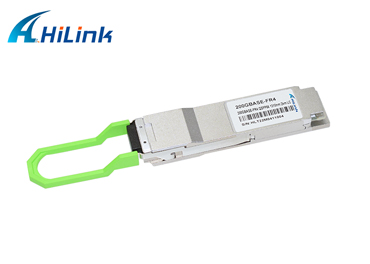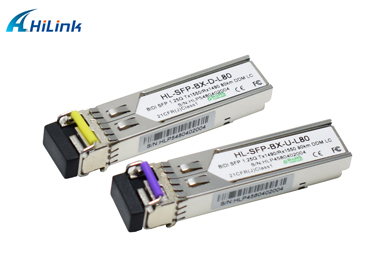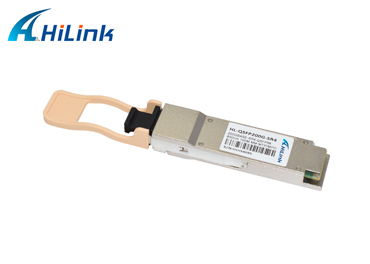What Is the Package of the Optical Transceivers Module?
Feb. 01, 2023
Optical transceiver module is the core device that can convert electrical and optical signals to each other in optical networks, which consists of optoelectronic devices, functional circuits and optical interfaces. The optoelectronic device includes two parts: transmitting and receiving. The transmitting part is the input of a certain code rate of electrical signals, driven by the internal driver chip, drive semiconductor lasers (LD) or light-emitting diodes (LED) to send out the corresponding code rate of modulated optical signals, optical internal power automatic control circuit, so that the output optical signal power to maintain stability. The receiving part is a certain code rate of the optical signal input module, through the light detection diode into an electrical signal that
Optical transceiver modules are widely used in optical transceivers, server NICs, switches, routers and wireless base station equipment. The classification of optical modules can be divided into single-mode and multi-mode by mode. They can be divided into hot-swappable and cold-swappable by usage conditions. It can also be distinguished by rate, such as the common 1G transceiver module, 10G transceiver module, 25G transceiver module, 40G transceiver module, and 100G transceiver module. However, the most common one is currently classified by package.
200G 2KM QSFP56 FR4
What is the package of optical transceiver module?
Optical module package is simply the shape of the optical module, with the progress of technology, the optical module is also constantly updated, from the appearance of it is constantly getting smaller. Of course, in addition to the appearance, the performance aspects of optical modules have also changed a lot, including speed, transmission distance, output power, sensitivity, operating temperature, etc.
According to the appearance (package) of optical modules can be divided into the following forms, such as QSFP28, CFP4, CFP2, CFP, QSFP+, SFP28, SFP+, XFP, X2, Xenpak, CSFP, GBIC, GBIC Copper, SFP, SFP Copper, SFF, 1 x 9 Etc. Because some of the intermediate types are rarely used, the following is a brief introduction to some of the more well-known types.
1.25G BIDI SFP 80KM
SFP
SFP (Small Form-factor Pluggable, can be simply understood as an upgraded version of GBIC, is the latest, but also the most widely used optical module products. sfp optical module inherits the hot-swappable characteristics of GBIC, while drawing on the advantages of SFF miniaturization. lc (SC connector only for single fiber bi-directional) optical connector, its volume is only GBIC module 1/2, greatly increasing the port density of network equipment (can be configured in the same panel more than twice the number of ports ) ) number) to adapt to the rapid development of the network.
Without exception, major equipment manufacturers have abandoned GBIC products and switched to SFP optical modules. Available wavelengths are 850nm, 1310nm, 1490nm, 1550nm, CWDM, DWDM. rates of 0-10Gbit/s. It is RoHS compliant and conforms to the SFF-8472 protocol.
XFP
XFP (10 Gigabit Small Form Factor Pluggable), "X" is the abbreviation of Roman numeral 10, which means 10G, all XFP modules are 10G optical modules. 10G bps SONET/SDH, Fibre Channel, Gigabit Ethernet, 10 Gigabit Ethernet and other applications, including CWDM, DWDM links. Follows XFP MSA protocol. Available wavelengths include 850 nm, 1310 nm, 1270 nm, 1330 nm, CWDM, DWDM at 10 Gbit/s.
Hilink 200G QSFP56 SR4 Optical Transceiver
SFP+
From the introduction of the standard in 2002, SFP+ has replaced XFP as the mainstream product in the 10G market by 2010. Following IEEE 802.3ae, SFF-8431 and SFF-8432 protocols, SFP+ retains the basic electro-optical and opto-electronic conversion functions and reduces the signal control functions of SerDes, CDR (Clock and Data Recover, EDC, MAC (Media Access Control)) in the original XFP design This simplifies the design of 10G optical modules. Power consumption is also smaller, XFP optical module volume reduced by about 30%, the same as ordinary SFP optical module, SFP + can meet the requirements of Fibre Channel 8.5G and Ethernet 10G in line with the ANSI T11 protocol, with high density, low power consumption, low system construction costs and other significant advantages, SFP + shielding requirements than the SFP more stringent, SFP +.
QSFP+
QSFP (Quad Small Form-factor Pluggable), a quad small form-factor pluggable optical module with four independent full-duplex transceiver channels. It was created to meet the market demand for higher density, high-speed pluggable solutions. QSFP+ transceivers can replace four standard SFP+ transceivers, resulting in higher port density and overall system cost savings over traditional SFP+ products. The optical module has two primary interfaces, LC and MTP/MPO.
The above is a brief introduction to the common packages of optical modules. If you want to know more about optical modules, please contact us.














